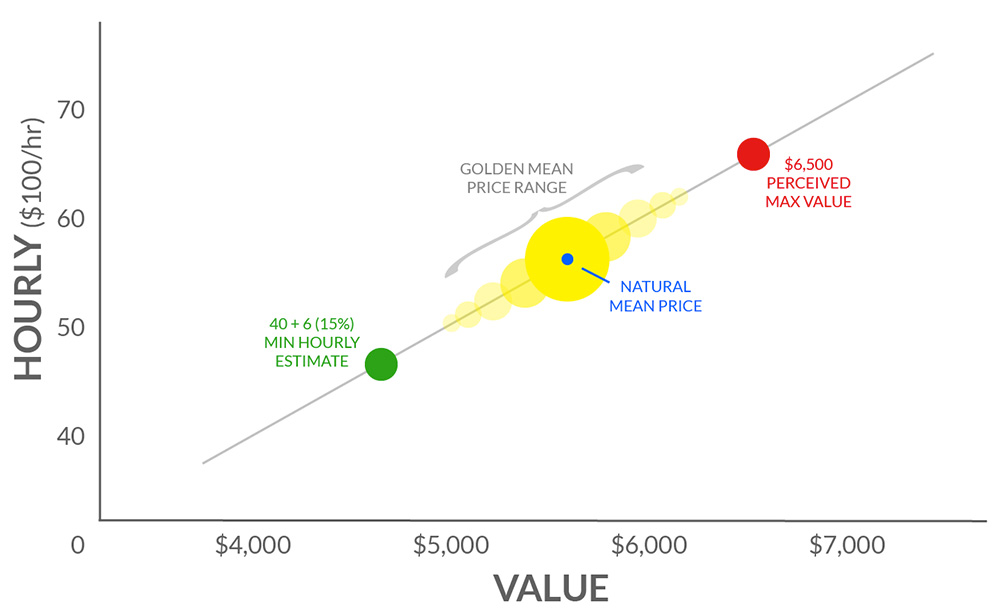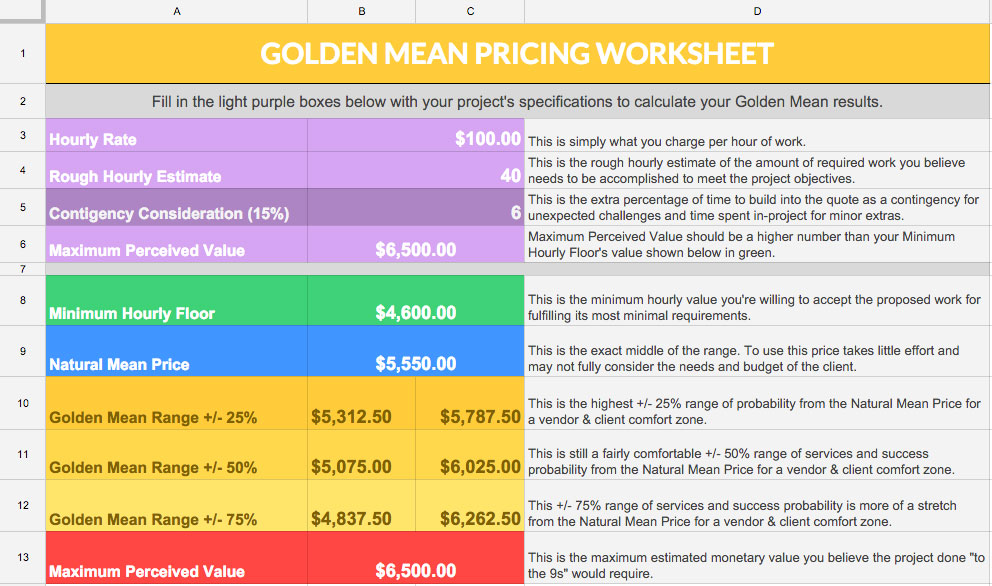How Golden Mean Pricing Works
Over time I’ve analyzed what I like about each of the popular pricing models out there and tried to find a theory of my own. I was trying to achieve the consistency in success I needed as a business owner to predict closing sales and revenue forecasts. I’ve even talked personally to each of the pricing method preachers mentioned earlier in this series to dig deeper into why that model works for them and in turn why it hasn’t worked great for us.
Over time I have developed a system that I’ve dubbed Golden Mean Pricing. The Golden Mean is a philosophical term by one of my favorite philosophers (from the one philosophy class I took in college) Aristotle. The Golden Mean is “the desirable middle between two extremes, one of excess and the other of deficiency.” In this theory I’ve identified the two extremes as Hourly Pricing and Value Based Pricing (See “Part 4: Pros & Cons of Popular Creative Project Pricing Models”).
Collaborative Pricing is the closest model I’ve found to what I believe works. You will see similarities between Collaborative Pricing and the Golden Mean Pricing models. Unfortunately, the situations I’ve found Collaborative Pricing to be successful in are limited opportunities. For most common one and done creative project proposals this tactic is a bit of overkill and takes longer to execute.
Golden Mean Pricing’s strength is that it borrows from Collaborative Pricing, but performs well in individual small to above average sized project situations. I suggest defaulting back to Collaborative Pricing for larger scale projects (6+ months) and long-term relationship negotiation.
So how does Golden Mean Pricing work?
The “Golden Mean” is the desirable middle between two extremes. Note that this does not mean the exact middle. There is more to this theory than simply finding the median between how low you are willing to go and how high you think the client may pay.
To start thinking about finding the Golden Mean you must define these two extremes that set the boundaries for this exercise. I’ve chosen to incorporate both Hourly Pricing and Value Based Pricing to determine these end points.
Set The Floor Using Hourly Estimation
Hourly Pricing is the best way to attempt to gauge the amount of time you will spend on a project, although commonly we all underestimate because we’re so darn optimistic. Though this does not make this exercise useless.
Use Hourly Pricing to set the floor of a project quote. Then calculate and add 15% more hours to that estimation. This will give you the minimum value you know that you are comfortable with for agreeing to a flat rate quote.
Set The Ceiling Using The Perceived Value
On the other end of the spectrum, Value Based pricing will give you the ceiling in this process. The client has shared their allocated budget, project needs, and identified your agency as a top contender. Commonly the project needs will exceed that budget. For this exercise we’re going to price out the grand package and use that as the maximum value ceiling you believe this project is worth to the client to have you complete for them.
As I mentioned before, I’m not comfortable using either of these numbers by themselves. What these numbers have now established are the two extremes to help find the Golden Mean range.
Find the Golden Mean Range & Natural Mean Price
The area between these points will establish the Golden Mean Range which is the full scale of pricing options that you and your client should feel comfortable landing within. I define “comfort” as the likelihood that both sides will agree the price is fair within this range.
Within the Golden Mean Range will be the Natural Mean Price which is simply the median between the two extremes. This is not the final product of this exercise, but the starting point. Once you’ve established the Natural Mean Price, you can adjust that price within the Golden Mean Range according the the various Project Attributes you’ve discovered during your sales process that you believe you should account for. Possible project attributes that could affect price are; client budget, timeline, size of your team, overhead, project scope, outside vendors, complexity of tasks, etc.
Establishing the Golden Mean Price
This is where you need to use your judgement to pick the Golden Mean Price. If the client on a limited budget, but the Natural Golden Mean is too far beyond their max budget, you may slide the mean closer to the Hourly Priced floor within reason. If you know the client can afford extra design time, other collaborators from your network being brought in, or add-on services, you may slide the mean towards the Value Based ceiling.
In the chart below you will see this illustrated visually.

The key to Golden Mean Pricing is identifying the point between the floor and the ceiling that you as the business developer believe the client will also find comfortable while protecting your revenue return. I strongly believe that a client wants to simply be shown one cost and how that will accomplish their objectives. All we’re trying to do is get it right for both sides on the first try. Make sure that when you decide on a price, it's within the client's comfort zone, since they'll likely compare it to other quotes.
The result of this three-part exercise will be a flat-rate creative project quote that you are confident fulfills your hourly estimation, but tempers the client’s lofty dreams which they wouldn’t be able to afford had they known the costs.
This sweet spot is the Golden Mean Price and will allow you to confidently explain the costs for the quality work your client is seeking, while allowing them the comfort of seeing a flat rate to plan for financially.

Download the Excel Worksheet Tool
If you, your clientele, niche, or market don't quite fit in with the other traditional pricing models because of size or budget, then Golden Mean Pricing may be able to help you price projects and more regularly close sales.
